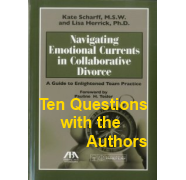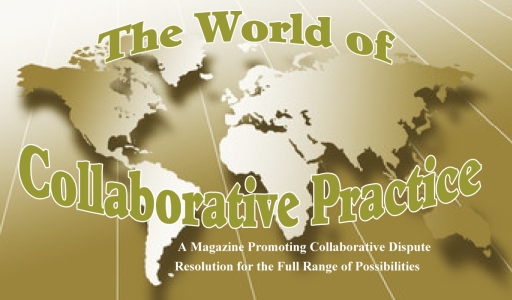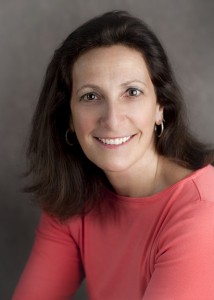
Tags
Related Posts
Share This
TEN QUESTIONS FOR LISA HERRICK AND KATE SCHARFF
Authors of Navigating Emotional Currents in Collaborative Divorce: A Guide to Enlightened Team Practice
Questions posed by Kevin R. Scudder, Collaborative Attorney, Seattle, WA
Kate and Lisa:
You wrote your book Navigating Emotional Currents in Collaborative Divorce in 2010. The book has been instrumental to me and other Collaborative Practitioners. I believe that your book is a must-read for anyone, Coach, Child Specialist, Financial or Lawyer, who wants to work in Collaborative Law. I said as much in the review of your book posted in the World of Collaborative Practice at
https://theworldofcollaborativepractice.com/?p=1626 and suggested that your book was best read in an inter-disciplinary practice group setting.
When I first read the book I was struck by the fact that it was written relatively early in your post-Collaborative Basic Training years. The insights you offer in your book made it seem that you had actually been practicing Collaborative work for much longer.
Now a few years have passed since the book was published. I thought it would be interesting to check in with you both to see how you look at the book now that it has been an important part of our learning libraries. The way I have chosen to approach this task is to ask you these Ten Questions:
1. What made you decide to write Navigating?
KATE: It was a natural evolution. Lisa and I met at our first Collaborative training in 2006. We started spending a lot of time together– working on teams, helping to build the DC practice group, attending trainings. Collaborative was the model we hadn’t known we’d been looking for. It galvanized us. Those early years were a long, almost uninterrupted conversation between us about how to apply our therapeutic knowledge and expertise in this new context—how to understand our clients more deeply, how to practice more effectively, how to make use of each other in helping divorcing couples access their highest selves and achieve best possible outcomes.
LISA: The books that had already been written by Pauline Tesler, Peggy Thompson, Stu Webb, Ron Ousky and important others provided a solid roadmap for moving into the work effectively and learning to do it competently. But we thought there was a missing piece. We’d observed that the most successful cases were those in which the emotional lives of the clients were tracked and attended to. The cases that went badly were those in which old marital dynamics were alive and went unaddressed—in the couple and in the team. We wanted to provide ourselves and our colleagues with a systematic way of thinking about what many people were already doing—trying to understand and make use of the the marital/interpersonal dynamics that were the undercurrents below the protocols.
2. Was the response to your book what you expected? What was your reaction to the feedback received?
LISA: From the start, readers – our colleagues – told us they found the book really helpful to their work. That was incredibly gratifying and exciting. One thing we began to notice as the months passed after our book was published was that our own community – our teammates, our friends – began using some of the language we coined in the book.
KATE: Most of the theoretical ideas in our book are borrowed from existing psychological literature. But we did shape and organize them into new models and conceptualizations that we hoped would be accessible and useful to all Collaborative professionals. Now, when we hear colleagues describe a couple’s “Lock and Key” fit, reflect on where a client falls on the “Rigidity/Flexibility Continuum, or wonder how to create a strong “Macrocontainer” (without remembering where or when they learned those terms), it tells us that the concepts have moved into the general lexicon and taken on independent lives. That’s awesome, because it confirms that there’s a huge community of folks who, like us, view the work as an ongoing learning process.
3. What is your favorite part of the book?
LISA: Well, I love the Lock and Key concept, and the narrative descriptions we wrote to capture that phenomenon. I find the idea that couples come together for both conscious and unconscious reasons (and you need to understand both) useful with every couple I work with. In fact, I talk to couples I see in marital therapy about their Lock and Key dynamics. They always find the idea easy to grasp and fascinating to think about, both in the context of their shared relationship and in their independent lives. Kate came up with the idea of creating cartoons for the book, and riffing with each other about the Lock and Key cartoon led to general hilarity. We had fun with it…
KATE: Yeah, it’s not a coincidence that one of our cartoons features two professionals in a wine bar.
Choosing a favorite makes me feel like a bad parent. Well, OK: Maybe the Rigidity/Flexibility Continuum, because it came to us in one of those great “aha” moments and offers a shorthand way to assess a client’s capacity for transformation. It doesn’t pathologize anyone, and you don’t need a doctorate to understand and use it. But don’t tell the Lock and Key I said that.
4. If readers could take only one thing from Navigating, what would it be?
KATE: Follow the affect, really lean into it. Every moment of every case – every meeting, every email, every team call– contains a universe of feelings from the past and present. The more people in the room, the more complex—a seven-way is like an emotional billiard table. Sometimes things get heated. For many of us (particularly lawyers who have been trained not to ask a question they don’t already know the answer to), the reflexive response is to try to smooth things over. Moving toward pain or aggression can be tough, but it’s crucial because emotionally fraught moments in are the moments when positive change is possible. When clients become overwrought or behave irrationally, it’s easy to forget that we’re all influenced by past traumas– especially when we’re under stress and often in ways we’re not aware of. When we can hold that truth in mind, we can maintain empathy. Empathy leads to understanding. Understanding leads to good outcomes.
LISA: The bottom line: When you understand and maintain an awareness of the particular currents flowing beneath each conversation, options for how to handle the conversation are revealed. In Collaborative Practice, a cigar is rarely “just a cigar.” An argument about the Christmas ornaments isn’t about the ornaments, and a reaction to a spousal support number isn’t just about the number. If a colleague blows up at you on a team call, it’s probably for complicated reasons that might have to do with your colleague, with you, and/or with the feelings the clients are triggering in both of you.
5. Would you structure the book any differently now?
LISA: Actually, we were both pleased with the way the book flowed (each concept building on the other), and we like our “boxes” and diagrams featuring concepts we wanted to highlight. But we would expand the chapter on child specialist work – we actually have a lot more to say about ways to understand children in Collaborative and work with parents around that understanding. We regretted that the chapter was brief, and that is definitely an aspect of the work that we want to write more about.
KATE: We’ve heard from practice groups around the country that they’ve read “Navigating” together, chapter-by-chapter. And sometimes, when we teach in other communities, folks ask us for suggestions for how they can continue working with the ideas after we’ve left. When we do the second edition of “Navigating” (and in future writings projects) we’ll add optional “learning modules” for each chapter—short study guides with suggested experiential exercises, vignettes for role-plays, discussion topics, etc.
6. How have you grown, professionally and personally, since writing “Navigating”?
LISA: Well one thing we’ve learned is that when a case looks “easy” at the start, and the clients seem “lovely,” you better buckle your seat belts and get ready for some surprises down the road. Kate has a saying that I love: ‘When you don’t see any anger, you gotta ask – WHERE IS IT???” I have learned that lesson over and over again.
KATE: Writing the book (and teaching about it) forced us break down what we do into component parts, examine them, and reconstruct them in a refined form. That process helped us get much better at the work, and made us curious and hungry to push the envelope. Also, in the years since “Navigating” came out we’ve internalized the concepts we wrote about (and Collaborative ideals in general) to the point that they’re reflexive. We find we’re applying them in all the work we do– and in our personal lives. I think I’m more empathic than I used to be, less defensive in the face of aggression, more “in the moment.” But I still have a long way to go.
7. How have your trainings been impacted by your writing – and vice versa?
KATE: We both love teaching and writing, though Lisa has more confidence as a trainer, while I seem have more confidence as a writer. It’s a collaborative relationship in the best sense of the word—we have a great Lock and Key. We coax each other out of our respective comfort zones, but we’re always thrilled to have been coaxed. Over the years we’ve also worked with other Collaborative colleagues on training teams, mostly as faculty members of The Collaborative Practice Training Institute (CPTI). Every time we teach we learn new ways to clarify and refine concepts so they’ll make more intuitive sense to our learners. We always learn more than we teach.
LISA: One great example of the interplay between training and writing stems from our use of live demonstrations during our trainings. When we demonstrate a specific type of meeting with clients or a specific interaction between teammates, we use a teaching technique called the “freeze frame.” I’m sure CPTI didn’t invent that technique but it’s incredibly helpful in slowing down the action and allowing the audience to explore very specific moments during any given interaction. As trainers, we freeze the action and then process the moment with our learners. They have all sorts of fascinating questions, ideas, and suggestions for what one could do in those moments to make them more successful for our clients. Out of that repeated training experience came a curriculum we wrote with Barb Burr, a colleague who is an attorney. We began teaching a workshop called “In the Moment: Anguish, Anxiety, and Aggression.”
8. May we hear more about what you are thinking and writing about these days?
KATE: In Collaborative, in fact in any cooperative divorce process, we ask our clients to make a tough paradigm shift of their own. We ask them to relax their grip on the past and be open to new ways of thinking and being—all in the face of massive loss and destabilization. It begs the question: What are the optimal conditions in which a person under duress can navigate tough emotional terrain, make constructive decisions, and even “grow” through the process? These days Lisa and I are putting our divorce work under a high-resolution microscope. We’re focusing on what conditions must be present in order for an individual or couple to achieve positive change (their own highest level of transformation) and how we, as practitioners, can establish and maintain those conditions. We know that our relationships to our clients and colleagues are our most important tools.
So it stands to reason that most of the conditions for positive change are the particular qualities of those relationships and the specific interactions within them. We’re working to translate those qualities and interactions into concrete, teachable techniques. Discussions with Barb have led to some really interesting ideas about what “mastery” means in our field, and about how to help divorce professionals of all stripes learn to work at the top of our professional games and achieve the best outcomes for our clients.
LISA: We have realized that so many of the psychological ideas that help us achieve successful outcomes in Collaborative are just as helpful in other models of dispute resolution. Any time a professional is interested in not only obtaining a good financial or custody outcome for a client, but also in helping the client grow in emotionally healthy ways, that professional needs first to become entranced with the idea of getting to know themselves a lot better and growing right alongside their client. We are coming to realize that “mastery” in our work means getting really good at promoting positive change in our clients – and in ourselves.
9. What drew each of you to work in the divorce field?
LISA: I have been working with couples and families since graduate school. Ten years into my private practice I found myself particularly challenged by working with high conflict parents struggling to cope post-divorce, and I spent quite a bit of time learning how to be effective with really angry, anguished people. When I was later drawn into Collaborative practice, I found a niche that seemed made for my interests and skills. It didn’t hurt that I had gotten my own divorce along the way. All through that torturous experience, and still today, remarried and recovered, I find the struggles of families in the midst of separation and divorce compelling.
KATE: When I finished grad school the first intensive psychotherapy training I did (even before individual and couple therapy) was in child and family therapy. I was a child of a nasty divorce that still echoes in my family today. The desire to understand why my parents (who were well-intentioned) mishandled things so profoundly and the wish to help other families manage the divorce transition in less destructive (and more child-centered) ways has been a big driver for me professionally. Personally, too—no denying there’s self-healing in this work. I also find I’m suited to divorce work and it to me. I love doing psychotherapy, but I was never happy in full-time solo practice. I love working on teams, and I love the variety—clinical work, Collaborative work, teaching, writing.
10. I understand that each of you have been divorced? How does going through that experience affect your work?
LISA: What I often notice in my work are the moments when my clients express “ugly” feelings, when they describe thoughts and behaviors that are not at all appealing. Yet in those moments I generally realize I have been there, I’ve felt a version of those emotions – even the most irrational or unreasonable feelings. So I can dig deep, even when the work is the hardest. I can remember my own moments of suffering or of rage, and the moments with my clients make sense. On the up side, I know I survived divorce, and I emerged whole and happy. So did my kids. So when my clients are at their most hopeless, I can hold some optimism for them, and really believe it. My hope for them is genuine. I know the future can hold promise even when it looks devoid of light.
KATE: I resonate with everything Lisa said. Divorce is humbling. I kept a few of the emails I wrote to my soon-to-be ex all those years ago; I came across as embittered and irrational, but I was grieving and terrified. Our work is hard. In the course of a busy day it’s natural to become impatient, judgmental, or numb towards our clients—especially the more abrasive ones. So I think of those emails and remember what it felt like to be on the edge of that precipice—facing the most primitive kinds of fears and losses. Then I can get in touch with the wounded, frightened part of my client and join with them in an authentic way. On the other hand, I also have to be vigilant about not bringing my old pain (and attendant over-identifications or biases) into the room. That effort is at the core of work: Joining with our client without merging with them creates a bond with transformative potential.
***********
| Lisa Herrick, Ph.D. is a licensed clinical psychologist who has worked with children, families and couples for twenty-five years. She is a former President of the D.C. Academy of Collaborative Professionals (DCACP) and former Co-Chair of Collaborative Professionals of Northern Virginia (CPNV). Dr. Herrick has worked as a Collaborative Coach and as a Child Specialist for more than eight years and is a founding member of the Collaborative Practice Training Institute (CPTI). Most recently, Dr. Herrick co-founded the Collaborative Practice Center of Greater Washington, where mental health, legal and financial professionals share space, and work together to promote Collaborative endeavors. www.lisaherrick.com | |
 |
Kate Scharff, MSW, LCSW-C, LICSW is a psychotherapist, mediator, parent coordinator, divorce consultant, and senior Collaborative practitioner/trainer with 25 years of clinical experience. She has taught and published widely in the areas of psychotherapy, divorce, and, more recently, Collaborative Practice. As a founding faculty member of the Collaborative Practice Training Institute (CPTI), Ms. Scharff has conducted trainings on a variety of topics. She is the author of Therapy Demystified: An Insider’s Guide to Getting the Right Help, Without Going Broke. Ms. Scharff is also a founder and Principal of the Collaborative Practice Center of Greater Washington and a founding board member and past President of the DC Academy of Collaborative Professionals. She maintains a private practice in both Washington, DC and Bethesda, MD. www.katescharff.com |












Share your thoughts here and in your network.